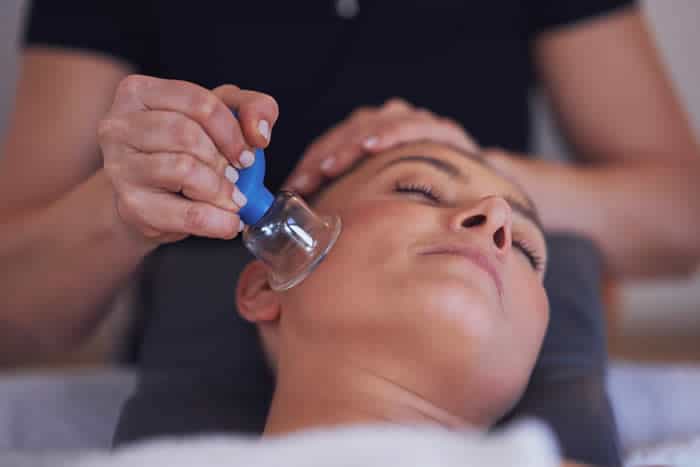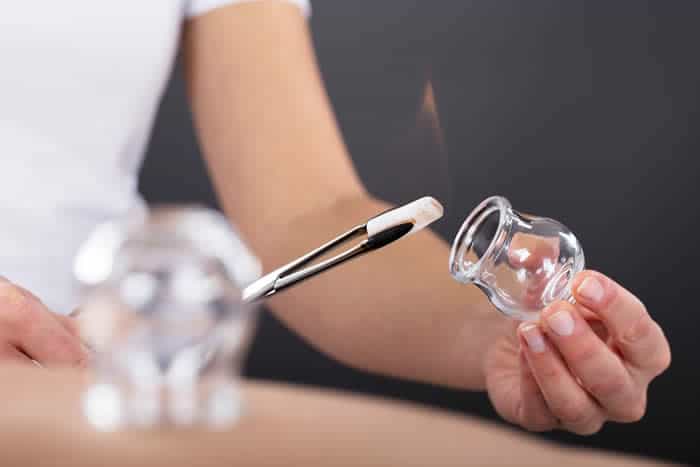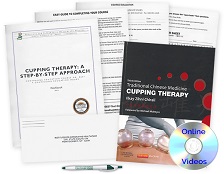

Cupping has become amongst the most demanded services in the massage and bodywork industry. Ever since Michael Phelps highlighted the virtues and benefits of cupping during the 2012 summer Olympics, consumer demand for cupping sessions has skyrocketed. This has resulted in numerous cupping courses nationwide. Many continuing education instructors and entry level massage programs have presented cupping to students fervently for the past decade. With the copious amount of information available about cupping regarding indications and benefits, it is wise to provide reminders on cautions and contraindications on cupping usage.
This article will first outline cautions and contraindications for cupping usage upon the body at large, then outline these items for the face specifically.
Before delving into the lists, it is important to remember the intention of cupping related bodywork. Cupping produces a negative pressure within the body to pull upon structures. This is different than typical massage application which creates a positive pressure to press into structures. Pulling rather than pushing creates a different sensation within the body and causes either micro or significant stretching of connective tissue fibers.
19 Body Cupping Cautions and Contraindications
A general rule in cupping is that conditions manifesting with Heat, Inflammation, Infection and/or Skin Fragility are cupping contraindications.
Below is a list provided of common conditions fitting within the general rule parameters. If a client presents with an unusual case or condition, inquire if their case fits the general rule.
- Acute inflammation injury. Usually acute inflammation takes 48-72 hours to process within the body but could take longer if a client has slower immune responses.
- New and unhealed/healing scars. One should wait until a scar heals to the point in which scar tissue skin tonicity and color match the surrounding tissue.
- Cellulitis. This skin infection may spread beneath the skin quickly. Ensure this infection has cleared before any cupping is performed.
- Significant dehydration which manifests as fatigue, dizziness, confusion, dark-colored urine, oliguria, and extreme thirst.
- Difficulty detoxing due to kidney or liver conditions such as renal failure or cirrhosis.
- Diabetes Mellitus. This condition weakens immune responses so a client may not heal or recover as sufficiently as expected after cupping.
- Areas of peripheral neuropathy. These areas will hamper sensory perception which is vital for a client in providing sufficient feedback about the impact of cupping upon their body.
- Injury recovery region such as dislocations, hernias, fractures. Allow the body sufficient healing time before pulling upon the connective tissues supporting bone and joint structures.
- Connective tissue disorders such as Ehlers-Danlos and Marfan’s Syndromes. Due to the pulling effect upon connective tissue fibers, cupping may stretch and pull fibers too much causing injury to the client’s connective tissue structures.
- Unmanaged high blood pressure. Too many capillaries may break causing extreme petechiae to occur.
- Dermatitis and related inflammatory skin conditions. Make sure inflammation has subsided before attempting cupping to avoid exacerbating inflammation effects.
- Frail skin due to disease process or aging. Pulling upon fragile skin could potentially injury collagen skin fibers.
- Excessive skin, especially post operation. Allow skin affected after surgery sufficient healing time.
- Skin lesions resulting in open wounds, sunburns and blisters as cupping will exacerbate injury to the skin while these lesions are actively healing.
- Vascular abnormalities such as deep vein thrombosis, varicose veins, and Raynaud’s phenomenon.
- Clients taking blood thinning medications. Cupping will pull on connective tissue supporting blood vessels causing them to be more prone to breaking open.
- During times of fasting. This is especially true if a client is not used to fasting. However, even if a client is used to regular fasting routines, remember that cupping challenges tissues metabolically so their body may have enough fuel to repair itself adequately during times of fasting.
- Orifices or eyes as these structures will be damaged with cupping.
- Oncology patients. Generally, you want to avoid causing inflammation in oncology patients. Wait until they are in NED status (no evidence of disease) before attempting cupping.
Always remember to remove cups if skin becomes excessively itchy (pruritic), painful and/or intolerable for the client.
11 Facial Cupping Contraindications

The most common conditions witnessed will be listed here. If a client presents with an unusual case or condition, inquire if their case fits the general rule. Many of the conditions listed above in “body cupping contraindications” may apply to facial cupping as well.
Conditions specific to the facial region include:
- Any class of burns including those caused by sun exposure and chemical exposure.
- Acute warts, cold sores, lumps, or infections, including cellulitis.
- Recent dermaplane treatments. Since this treatment exfoliates the skin there will not be enough skin to pull safely. Wait at least one week before attempting cupping.
- Dermatitis (eczema) as any inflammatory condition can exacerbate with cupping.
- Active viral infections such as herpes simplex, herpes zoster, molluscum contagiosum, and verruca vulgaris.
- Recent botox or filler injections. A conservative estimate is to wait at least four weeks after botox or filler infections before cupping can be applied to the face.
- Untreated acne and rosacea. Ensure these conditions are treated first before any cupping is applied to the skin.
- Recent treatments of Accutane. This treatment for acne reduces the amount of sebum upon the skin and is quite powerful. Wait at least two weeks after treatment to ensure treatment has time to work sufficiently.
- Skin treated with Retin-A. This treatment for acne significantly thins the skin. Wait at least two weeks after treatment to make sure treatment has time to work sufficiently.
- Clients with challenged skin biofilm, which occurs with clients who are prone to frequent skin infection. Lupus and other autoimmune patients need to be monitored closely with cupping sessions to detect how quickly their bodies react.
- Recent cosmetic procedures such as lifts, enhancements, liposuction and plastic surgeries. A conservative estimate is to wait at least four weeks after such procedures before cupping can be applied to the face.
Final Cupping Comments
Remember that scope of practice for cupping usage will differ depending on one’s location and professional title. Massage therapists will have a different scope of practice and indications for cupping usage than physical therapists and other health professionals which vary state to state.
Massage cupping does not utilize the fire method. Practicing only those methods that are within your scope of practice is vital. Should you have questions regarding acceptable cupping application within your scope of practice, please contact your state licensing board, certifying organization, and professional liability insurance provider for further details.

The lists provided are subject to discernment depending upon client cases. Perhaps a client has a stronger immune system and recovers from injuries or procedures faster which may change the time frames listed above for cupping usage. Always perform an evaluation with clients before attempting cupping and keep the general rule in mind with unusual or rare cases.













